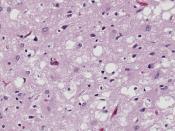Mad Cow Disease Variant Crutzfeldt-Jakob Disease was first reported in the United Kingdom in January 1994. Now known as "Mad Cow Disease" in the United States, scientists have researched the affects on humans and cows. It has been proven that it is a deadly, brain-destroying illness. Scientists are in the early stages of finding a cure for "mad cow disease" and keeping the United States from experiencing the same tragic epidemic that the United Kingdom went through just a few years ago.
Mad cow disease is a rare and fatal human neuro-degenerative condition. Like Creutz-Jakob disease it is classified as a transmissible spongiform encephalopathy because of its characteristic spongy degeneration of the brain and its ability to be transmitted. The difference in Creutz-jakob disease and mad cow disease is mad cow disease is infectious. Creutz-Jakob exist in only three forms. Sporadic cases of unknown cause, familial cases which are associated with a gene mutation, and cases of accidental transmission of the disease via contaminated surgical equipment or cornea or dura mater transplants, or the administration of human pituitary growth hormones.
Mad cow disease differs from this form because it has affected younger patients (average age 29 years as opposed to 65 years), has a longer duration of illness (average of 14 months as opposed to 4.5 months) and is strongly linked to exposure, probably through food.
From October 1996 to early December 2000, 87 cases of the disease have been reported in the United Kingdom, three in France and a single case in the Republic of Ireland.
Early in the illness, patients usually experience psychiatric symptoms, which most commonly take the form of depression or a schizophrenia-like psychosis. Unusual sensory symptoms, such as "stickiness" of the skin, have been experienced by half the cases. Neurological signs, including unsteadiness,


